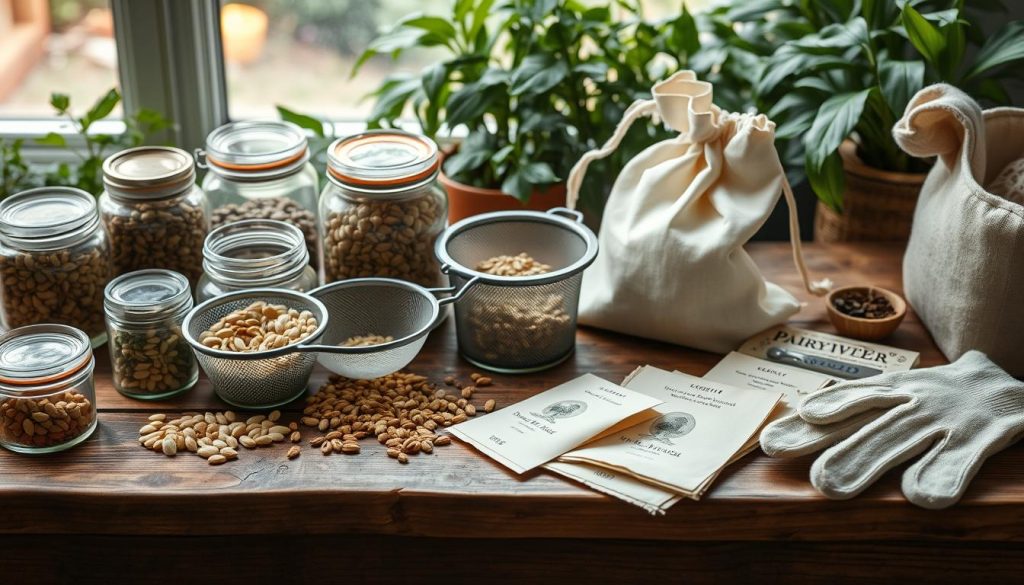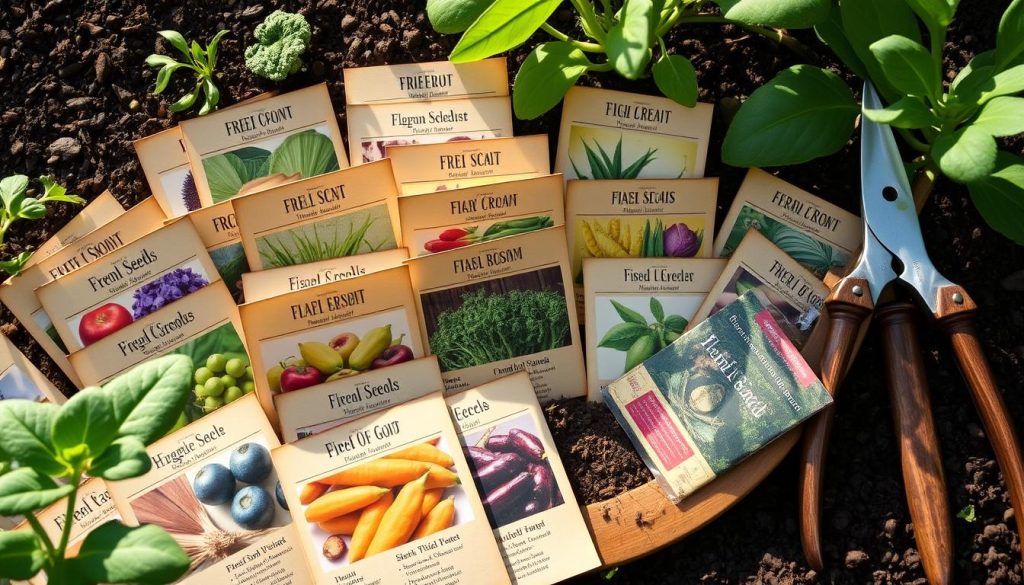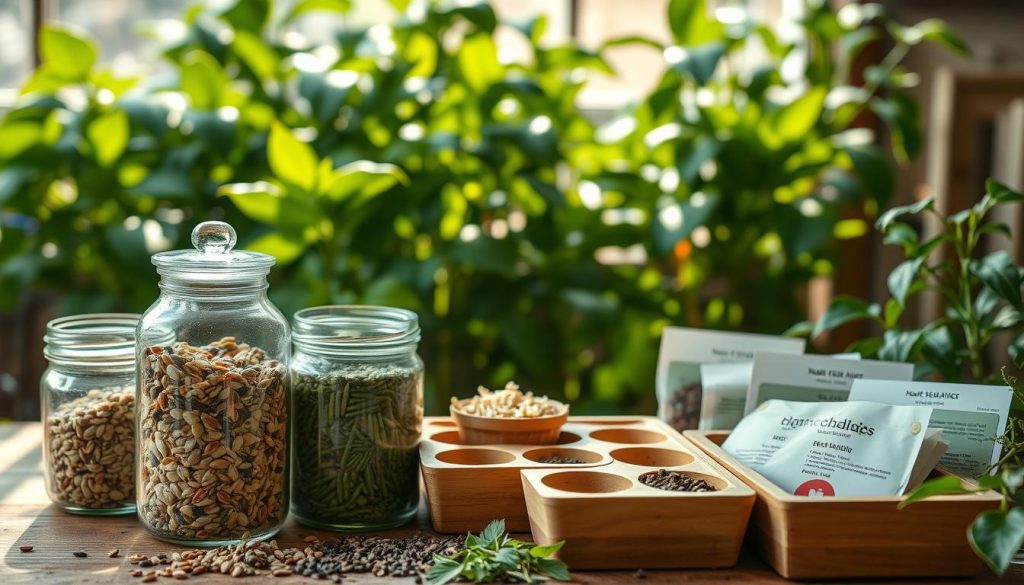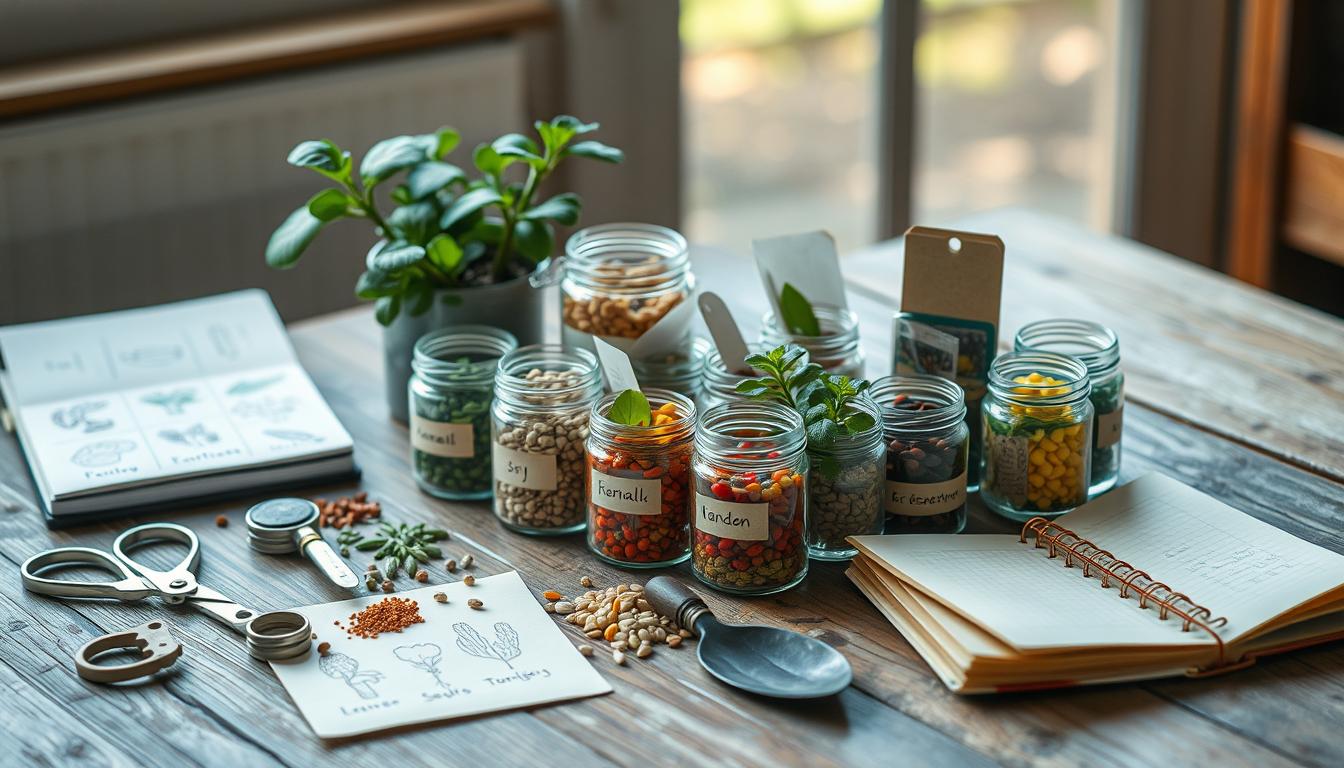As a gardener, I’ve found that seed-saving kits are essential. They help you collect, store, and sow seeds. This promotes a greener future, using heirloom seeds and key gardening supplies.
Seed-saving kits have everything you need to start saving seeds from your favorite plants. With the right tools, anyone can begin their seed-saving journey. They enjoy the rewards of sustainable gardening.
Seed-saving kits ensure a steady supply of your favorite seeds. This reduces the need for external supplies. It also encourages a more self-sufficient gardening approach with heirloom seeds.
What are Seed-Saving Kits?
Exploring organic gardening and sustainable farming, I’ve learned about seed-saving kits. These kits help gardeners save, store, and plant seeds. They encourage sustainable gardening and reduce reliance on commercial seeds, boosting biodiversity.
Seed-saving kits are key for gardeners wanting to go green. They make saving seeds easy, letting gardeners keep their favorites and share them. This method cuts down on waste and supports heirloom seeds, perfect for local conditions.
Understanding the Basics of Seed-Saving
Starting with seed-saving means learning the basics. You need to know how to collect, clean, and store seeds. Seed-saving kits come with tools like seed collectors and storage containers to help.
Benefits of Using Seed-Saving Kits
Using seed-saving kits offers many advantages. They help gardeners:
- Promote biodiversity with heirloom and open-pollinated seeds
- Lessen dependence on commercial seed suppliers
- Save money by growing their own seeds
- Share seeds, building a gardening community
Seed-saving kits are crucial for sustainable farming and organic gardening. They support the environment and preserve plant diversity. This ensures a healthier food system for generations to come.
Essential Tools Included in Seed-Saving Kits

Exploring seed preservation and home gardening shows the need for the right tools. Seed-saving kits are perfect for beginners. They come with tools for collecting, drying, and storing seeds. Let’s look at some key tools found in these kits.
Seed preservation is key in home gardening. It lets you save and reuse seeds from your favorite plants. A seed-saving kit helps you collect, dry, and store seeds properly. This keeps them viable. Here are some essential tools you’ll find in these kits:
- Seed collectors: These are used to gather seeds from your plants, and they come in a variety of shapes and sizes.
- Drying racks: These are used to dry your seeds, which helps to remove excess moisture and prevent spoilage.
- Storage containers: These are used to store your dried seeds, and they should be airtight and moisture-proof to keep your seeds fresh.
- Labels and markers: These are used to label and identify your seeds, which is important for keeping track of different varieties and planting schedules.
Using these tools ensures your seeds are preserved and stored well. This promotes healthy growth in your garden. Whether you’re new to gardening or experienced, a seed-saving kit is a valuable investment.
With the right tools and practice, you can become skilled at seed saving. This enhances your home gardening experience. Saving seeds can save you money and preserve heirloom varieties. By using seed-saving kits, you can elevate your gardening and enjoy a more sustainable experience.
How to Choose the Right Seed-Saving Kit
Choosing the right seed-saving kit can be tough, with so many options out there. It’s key to think about the seeds you want to save, your garden’s size, and your budget. Eco-friendly kits are great for those who care about the planet.
Look for kits made from sustainable materials and designed to cut down on waste. Brands like Burpee, Seed Savers Exchange, and High Mowing Seeds offer eco-friendly options. They have kits for all budgets and needs, making it easier to find what you need.
Factors to Consider
- Type of seeds: Different kits are for different seeds, like veggies, herbs, or flowers.
- Size of the garden: Bigger gardens need bigger kits, while smaller ones can do with smaller ones.
- Budget: Kits vary in price, from simple to advanced.
Popular Brands to Explore
Some top brands for eco-friendly seed-saving kits include:
- Burpee: They’re known for quality seeds and eco-friendly packaging.
- Seed Savers Exchange: A non-profit that promotes saving seeds and offers eco-friendly kits.
- High Mowing Seeds: They specialize in organic and non-GMO seeds, with a variety of kits.
By considering these factors and checking out these brands, you can find the perfect kit. It will help you garden while being kind to the planet.
Best Practices for Seed Harvesting

As a gardener, I’ve learned that timing is key for harvesting seeds. Heirloom seeds, passed down through generations, are special. They offer a unique advantage in gardening. To get the best results, I harvest my seeds when they are fully mature and dry.
Using the right tools, like seed collectors and drying racks, is important. Here are some best practices to keep in mind:
- Check the seeds regularly to ensure they are dry and mature
- Use a seed collector to gather the seeds and prevent them from getting damaged
- Store the seeds in a cool, dry place to preserve their viability
By following these best practices and using quality gardening supplies, I’ve successfully harvested and stored my heirloom seeds. This has allowed me to enjoy a bountiful harvest and share my seeds with fellow gardeners. Whether you’re a seasoned gardener or just starting out, using heirloom seeds and following these best practices can help you achieve success in your garden.
| Seed Type | Harvest Time | Storage Requirements |
|---|---|---|
| Heirloom Seeds | When fully mature and dry | Cool, dry place |
| Hybrid Seeds | When seeds are dry and hard | Airtight container |
Storing Your Seeds, Tips for Longevity
Keeping seeds in good condition is key for their survival and growth. As someone who loves organic gardening, I know how important it is to store seeds right. This helps them last longer and supports sustainable farming.
Optimal Conditions for Seed Storage
For seeds to stay fresh, they need a cool, dry spot. Use airtight containers like glass jars or seed vaults. Store them in a dark, cool place. The best temperature is between 40°F and 50°F, with humidity below 50%.
The Importance of Seed Testing
Testing seeds is vital for their storage. It shows which seeds are still good and which need to be replaced. This ensures only healthy seeds are stored, helping them germinate well. Consider these factors when testing seeds:
- Seed moisture content
- Seed temperature
- Seed storage duration
By following these tips, gardeners can keep seeds fresh and ensure a bountiful harvest.
Creative Uses for Extra Seeds

As a home gardener, I often have more seeds than I need. Instead of throwing them away, I’ve found many creative uses. Sharing seeds with my community is one of the best things I do. It helps grow biodiversity and brings gardeners together.
Sharing with the Community
Sharing seeds helps build friendships and a sense of community. I started a seed exchange in my neighborhood. We swap seeds and share gardening tips. It’s a great way to learn and meet people who love gardening as much as I do.
Starting Herb and Vegetable Exchanges
I also started an exchange for herbs and vegetables. It lets people swap their extra food for something new. This way, we all reduce waste and support green gardening.
- Fresh herbs like basil and rosemary
- Leafy greens like kale and spinach
- Vegetables like tomatoes and cucumbers
Being part of these exchanges has helped me reduce waste and find new plants. If you garden, I suggest finding a local exchange. It’s a fun way to meet others and learn more about gardening.
Environmental Benefits of Seed-Saving
Exploring seed-saving, I find it’s great for the environment. Using eco-friendly products and kits helps gardeners lessen their environmental impact. Saving seeds cuts down on waste. It means we don’t need single-use seed packets and packaging.
Reducing Waste
Here are ways to cut down on waste with seed-saving:
- Using reusable seed containers and labels
- Sharing seeds with fellow gardeners to reduce packaging waste
- Composting seed packets and other biodegradable materials
Promoting Biodiversity
Seed-saving boosts biodiversity by keeping heirloom and rare seeds alive. By saving and swapping seeds, gardeners help keep plant species diverse. This is key for a strong ecosystem. Eco-friendly products, like biodegradable starters and natural pest control, also help biodiversity. They reduce the need for harmful chemicals in gardening.
My Personal Seed-Saving Journey
As a passionate gardener, saving seeds has been a journey full of rewards. At first, I struggled with harvesting and storing heirloom seeds. But, with the right gardening tools and organic methods, I overcame these challenges.
Lessons Learned
One key lesson is the need for proper seed testing and storage. By checking seed viability and storing them right, I’ve kept them fresh for longer. Sharing seeds with local gardeners has also brought joy and helped spread biodiversity.
Rewarding Experiences
Watching my heirloom plants grow and harvest has been incredibly rewarding. Seeing the vibrant colors and unique tastes of my produce fills me with pride. It’s fulfilling to know I’m helping preserve these genetic treasures.

